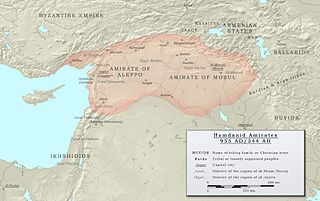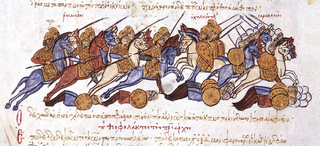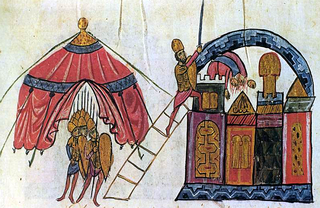Related Research Articles

Nikephoros II Phokas, Latinized Nicephorus II Phocas, was Byzantine emperor from 963 to 969. His career, not uniformly successful in matters of statecraft or of war, nonetheless included brilliant military exploits which contributed to the resurgence of the Byzantine Empire during the 10th century. In the east, Nikephoros completed the conquest of Cilicia and retook the islands of Crete and Cyprus, opening the path for subsequent Byzantine incursions reaching as far as Upper Mesopotamia and the Levant; these campaigns earned him the sobriquet "pale death of the Saracens". Meanwhile in the west, he inflamed conflict with the Bulgarians and saw Sicily completely turn over to the Muslims, while he failed to make any serious gains in Italy following the incursions of Otto I. At home, Nikephoros' administrative policies caused controversy. He financed his wars with increased taxes both on the people and on the church, while maintaining unpopular theological positions and alienating many of his most powerful allies. These included his nephew John Tzimiskes, who would take the throne after killing Nikephoros in his sleep.

The Hamdanid dynasty was an Islamic Arab dynasty of Northern Mesopotamia and Syria (890–1004). They descended from the ancient Banu Taghlib tribe of Mesopotamia and Arabia.

Abu Mansur Nizar, known by his regnal name as al-Aziz Billah, was the fifth caliph of the Fatimid dynasty, from 975 to his death in 996. His reign saw the capture of Damascus and the Fatimid expansion into the Levant, which brought al-Aziz into conflict with the Byzantine emperor Basil II over control of Aleppo. During the course of this expansion, al-Aziz took into his service large numbers of Turkic and Daylamite slave-soldiers, thereby breaking the near-monopoly on Fatimid military power held until then by the Kutama Berbers.

ʿAlī ibn ʾAbū'l-Hayjāʾ ʿAbdallāh ibn Ḥamdān ibn al-Ḥārith al-Taghlibī, more commonly known simply by his honorific of Sayf al-Dawla, was the founder of the Emirate of Aleppo, encompassing most of northern Syria and parts of the western Jazira.

Al-Harith ibn Abi’l-ʿAlaʾ Saʿid ibn Hamdan al-Taghlibi (932–968), better known by his pen name Abu Firas al-Hamdani, was an Arab prince and poet. He was a cousin of Sayf al-Dawla and a member of the Hamdanid dynasty, who were rulers in northern Syria and Upper Mesopotamia during the 10th century. He served Sayf al-Dawla as governor of Manbij as well as court poet, and was active in his cousin's wars against the Byzantine Empire. He was captured by the Byzantines in 959/962 and spent several years at their capital, Constantinople, where he composed his most famous work, the collection of poems titled al-Rūmiyyāt (الروميات). He was ransomed in 966, and was killed in 968, when he raised a revolt against his nephew Sa'd al-Dawla, Sayf al-Dawla's successor. He is considered among the greatest figures of classical Arabic poetry.
Peter was a Byzantine eunuch general. Originally a servant of the powerful Cappadocian Phokas family, he was raised to high military office under Emperor Nikephoros II Phokas, leading the capture of Antioch and the subjugation of Aleppo in 969. Under John I Tzimiskes, he fought as a senior commander against the Rus' in 970–971, while after Tzimiskes' death he led the loyalist forces against the revolt of the general Bardas Skleros in Asia Minor, falling in battle in autumn 977.
Abu Muhammad Lu'lu', surnamed al-Kabir and al-Jarrahi al-Sayfi, was a military slave (ghulam) of the Hamdanid Emirate of Aleppo. Under the rule of Sa'd al-Dawla, he rose to become the emirate's chamberlain, and on Sa'd al-Dawla's death in 991 he was appointed guardian of his son and successor, Sa'id al-Dawla. The able Lu'lu' soon became the de facto ruler of the emirate, securing his position by marrying his daughter to the young emir. His perseverance and aid from the Byzantine emperor Basil II preserved Aleppo from repeated Fatimid attempts to conquer it. Upon Sa'id al-Dawla's death in 1002—possibly poisoned by Lu'lu'—he became the ruler of the emirate, disinheriting Sa'id al-Dawla's sons. He ruled with wisdom until his death in 1008/9. He was succeeded by his son, Mansur, who managed to retain the throne until deposed in 1015/16.

The Battle of Raban was an engagement fought in autumn 958 near the fortress of Raban between the Byzantine army, led by John Tzimiskes, and the forces of the Hamdanid Emirate of Aleppo under the famed emir Sayf al-Dawla. The battle was a major victory for the Byzantines, and contributed to the demise of Hamdanid military power, which in the early 950s had proven a great challenge to Byzantium.

The Battle of Andrassos or Adrassos was fought on 8 November 960 between the Byzantines, led by Leo Phokas the Younger, and the forces of the Hamdanid Emirate of Aleppo under the emir Sayf al-Dawla. It was fought in an unidentified mountain pass in the Taurus Mountains.
Abu 'l-Ma'ali Sharif, more commonly known by his honorific title, Sa'd al-Dawla, was the second ruler of the Hamdanid Emirate of Aleppo, encompassing most of northern Syria. The son of the emirate's founder, Sayf al-Dawla, he inherited the throne at a young age and in the midst of a major offensive by the Byzantine emperor Nikephoros II Phokas that within two years conquered the western portions of his realm and turned Aleppo into a tributary state. Facing a multitude of rebellions and desertions until 977, Sa'd was unable even to enter his own capital, which was in the hands of his father's chief minister, Qarquya. By maintaining close relations with the Buyids, he managed to re-establish his authority in parts of the Jazira, but his rule was soon challenged by the rebellion of his governor Bakjur, who was supported by the Fatimids of Egypt. In turn, Sa'd came to rely increasingly on Byzantine assistance, although he continued to fluctuate in his allegiance between Byzantium, the Buyids, and the Fatimids.
Abu'l-Fada'il Sa'id al-Dawla was the third Hamdanid ruler of the Emirate of Aleppo. He succeeded his father Sa'd al-Dawla in 991, but throughout his reign real power rested in the hands of Sa'd al-Dawla's former chamberlain, Lu'lu', to whose daughter Sa'id was wed. His reign was dominated by the Fatimid Caliphate's repeated attempts to conquer Aleppo, which was prevented only by the intervention of the Byzantine Empire. Warfare lasted until 1000, when a peace treaty was concluded guaranteeing Aleppo's continued existence as a buffer state between the two powers. Finally, in January 1002 Sa'id al-Dawla died, possibly poisoned by Lu'lu', and Lu'lu' assumed control of Aleppo in his own name.
Bakjur was a Circassian military slave who served the Hamdanids of Aleppo and later the Fatimids of Egypt. He seized control of Aleppo in 975 and governed it until 977, when the rightful Hamdanid ruler, Sa'd al-Dawla, regained it. Given the governorship of Homs, in 983 he went over to the Fatimids and launched an attack on Aleppo, which was defeated through the intervention of Byzantine troops. Bakjur then became governor of Damascus for the Fatimids until 988. He made a last attempt to capture Aleppo in 991, which again was defeated thanks to Byzantine assistance. Bakjur was captured by Sa'd al-Dawla and executed.

Abū'l-Fawāris Muḥammad ibn Nāṣir al-Dawla was a Hamdanid prince, active as a governor and general for his uncle, Sayf al-Dawla, Emir of Aleppo.
Rashiq al-Nasimi was the governor of Tarsus for the Hamdanid emir Sayf al-Dawla from 962 until the city's surrender to the Byzantine emperor Nikephoros II Phokas in 965. He then took over Antioch, and launched a failed attack on the Hamdanid capital, Aleppo in early 966. He took the lower city and besieged the citadel for over three months, but was killed and his men fled back to Antioch.

Sa'id ibn Hamdan was an early member of the Hamdanid dynasty who served as provincial governor and military leader under the Abbasid Caliphate. He was the father of the celebrated poet Abu Firas al-Hamdani.

The Byzantine conquest of Cilicia was a series of conflicts and engagements between the forces of the Byzantine Empire under Nikephoros II Phokas and the Hamdanid ruler of Aleppo, Sayf al-Dawla, over control of the region of Cilicia in southeastern Anatolia. Since the Muslim conquests of the 7th century, Cilicia had been a frontier province of the Muslim world and a base for regular raids against the Byzantine provinces in Anatolia. By the middle of the 10th century, the fragmentation of the Abbasid Caliphate and the strengthening of Byzantium under the Macedonian dynasty allowed the Byzantines to gradually take the offensive. Under the soldier-emperor Nikephoros II Phokas, with the help of the general and future emperor John I Tzimiskes, the Byzantines overcame the resistance of Sayf al-Dawla, who had taken control of the former Abbasid borderlands in northern Syria, and launched a series of aggressive campaigns that in 964–965 recaptured Cilicia. The successful conquest opened the way for the recovery of Cyprus and Antioch over the next few years, and the eclipse of the Hamdanids as an independent power in the region.
The Treaty of Safar put a formal end to the extended collapse of the Hamdanid Dynasty. It was signed in December 969/January 970 between the Byzantine stratopedarches Petros and the former minister of the Hamdanids and rebel, Qarquya. Following the death of the Hamdanid emir Sayf al-Dawla in 967, rebellion quickly enveloped the Hamdanids and the dynasty disintegrated into chaos and disorder. The Byzantines saw this as an opportunity to finally take control of Aleppo. Petros soon approached Aleppo, probably without orders from Constantinople, and took the city in January 970.

The siege of Antioch in 968–969 was a successful military offensive undertaken by leading commanders of the Byzantine Empire in order to reconquer the strategically important city of Antioch from the Hamdanid Dynasty.

The sack of Aleppo in December 962 was carried out by the Byzantine Empire under Nikephoros Phokas. Aleppo was the capital of the Hamdanid emir Sayf al-Dawla, the Byzantines' chief antagonist at the time.